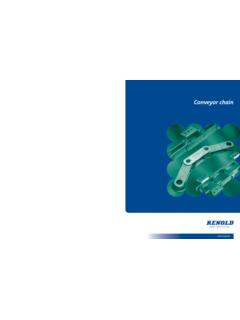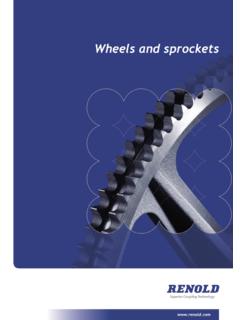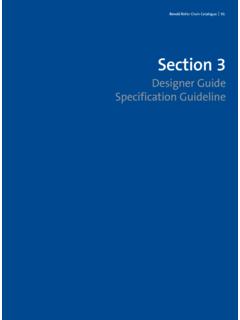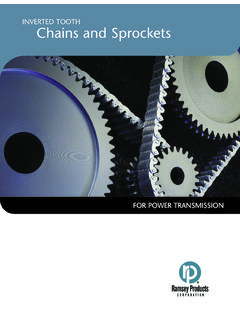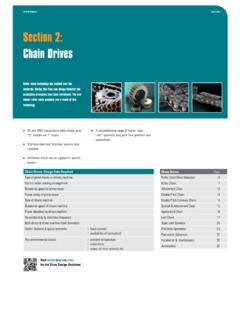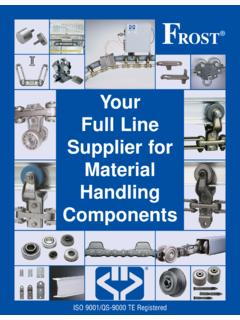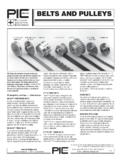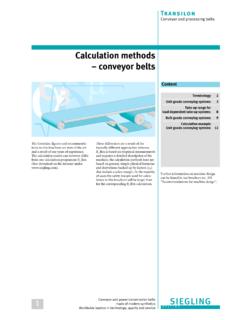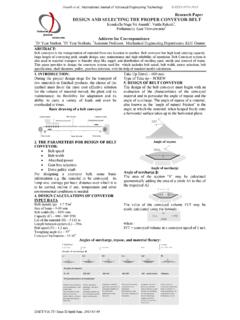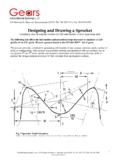Transcription of Development of Early Roller Chain Technical Information
1 Advancing Chain technology215 Design GuideTechnical Information29 Development of Early Roller ChainAs the industrial revolution gained pace, the need for higherperformance Chain ensured that the product did not standstill. A quick look at the 1880 patent would give the impressionthat there is no difference between it and modern concept, this is true. However, Early Chain performancewas very much constrained by design knowledge, materialsophistication, and production processes. For example,in order to achieve a close tolerance on round parts, HansRenold also pioneered centerless grinding and, at onetime, had a whole section devoted to grinding cold drawnbar to size before further shortcomings of available technology meant that,comparedwith modern Chain , there were low strength to weight ratios, erratic pitch control, poor engagementcharacteristics, and a tendency toward point loading;causing high bearing pressures, wear, and failure.
2 The ever-increasing number of applications for Chain resulted in a continuous refinement of our production processesand the introduction of heat treatment, improving RenoldChain to meet these new and arduous ChainToday there is a very wide range of Chain products of these are special low-volume products, for example,nuclear-waste-handling Chain . Motorcycle Chain and otherhigh-volume products are an offshoot of one of the keygroups shown the top level of the Chain groups, conveyor Chain isperhaps the most difficult to compartmentalize, since mosttypes of Chain can be used to convey. There is, however, arange of so-called conveyor Chain products typified bytheir long pitch, large Roller diameter, and emphasis ontensile strength rather than fatigue link Chain , like conveyor Chain , is intended to run only at low speeds, since the presence of an offset linkplate will reduce fatigue life.
3 This Chain tends to be used in conveying applications where harsh environmentalconditions prevail, in mineral excavation, for Chain is similar in construction to the old Galle Chain ,except that plates are interleaved in various configurationsright across the width of the pin. This means that there is no way of providing sprocket engagement and the Chain can only be used to transmit force through suitablyanchored ends. Chains are guided around simple plainpulleys. Perhaps the best example of the use of leaf chainis in the lifting mechanism of a forklift leaves the most important group of Chain , the Europeanand American series of transmission Roller Chain . TheEuropean (from the British Standard) range grew out ofthe Early pioneering work of Hans Renold, as mentionedpreviously, and the size of components through this rangetherefore reflected a growing understanding of chaindesign and likely was influenced by the availability ofstock material sizes.
4 The American, or ANSI, range, whichcame later, has a clear mathematical theme, whereby thesizes of components are calculated in accordance withexpressions now quoted in the ANSI standard TheANSI range of Chain is shadowed by a range of similarchains, heavy series, which use the side plate material fromthe Chain of the next highest size. This results in a range of chains with higher fatigue life but not necessarily highertensile strength, since the pin diameters are European and ANSI ranges of Chain are available in double pitch and rollerless Chain forms. Double pitch is primarily another form of conveyor Chain that uses theround parts from a standard Chain , but has twice the Chain is simply Roller Chain without a Roller and is also the only design configuration possible on very smallpitch Chain , such as 4mm and ANSI 25 or 1/4-inch Chain is used for lightly loaded applications orthose requiring only direct FAMILY TREER ollerChainLeafChainConveyorChainEuropean (BS)RangeAmerican(ANSI) 11/19/08 11:51 AM Page advancing Chain technology216 Design GuideTechnical Information29 Modern Chain has features that enable demandingapplications to be tackled with ease.
5 These include highwear and fatigue resistance, as well as transmissionefficiency of approximately 98 is also now manufactured in multiple strands joinedtogether by a common pin, giving more scope for increasedpower transmission in restricted space. The range ofproducts now available with alternative materials, specialcoatings, endless varieties of attachments, hollow bearingpins, and anti-backbend, to name just a few give scopefor the widest portfolio of design solutions Jeffrey's experienced Technical staff is available toconsult with you as to which design solutions are the mostappropriate for your specific with improvements to factory-applied greases andbetter understanding of applications, designers can nowspecify transmission Chain with PerformanceRenold Jeffrey Chain products that are dimensionally in line with the ISO standards far exceed the stated minimumtensile strength requirements.
6 However Renold does notconsider breaking load to be a key indicator of performancebecause it ignores the principal factors of wear and these areas, Renold products are designed to produce thebest possible results and independent testing proves this catalog, where the breaking load is quoted, it shouldbe noted that we are stating that the Renold product conformsto the ANSI minimum standard. Independent test resultsshow that the minimum (many companies quote averages)breaking loads were far in excess of the ISO the quoted breaking load is not described as beingthe ANSI minimum, the product has no relevant ISOstandard. In this case, the breaking loads quoted are theminimum performance of a Chain is governed by a number ofkey factors. The tensile strength is the most obvious sincethis is the means by which a Chain installation is roughlysized.
7 However, since a Chain is constructed from steel,the yield strength of which is around 65 percent of theultimate tensile strength, any load above this limit willcause some permanent deformation to take place withconsequent rapid to the s-n curve below shows that at loads belowthis 65 percent line, finite life may be expected, and, atsubsequent reductions in load, the expected life increases until thefatigue endurance limit is reached at around8,000,000 below the endurance limit will result in infinite fatiguelife. The failure mode will then become wear related, whichis far safer, since a controlled monitor of Chain extensioncan take place at suitable planned intervals. In practice, ifa load ratio of tensile strength to maximum working load of8:1 is chosen, then the endurance limit will not normally beexceeded.
8 Careful consideration of the expected maximumworking loads should be given since these are often muchhigher than the designer may think! It is also a requirementthat any passenger lift applications are designed with asafety factor of not less than 10 most applications, wear is the designed failure mode andtherefore, some consideration of how a Chain behaves inthis mode are shown of the wear characteristics graph belowshows that Chain tends to wear in three distinct first phase, shown as bedding in, is a very rapidchange in Chain length associated with componentsadjusting to the loads imposed on them. The degree ofthis initial movement willdepend to a largeextent on the quality of Chain used forexample, goodcomponent fits, chainpre-loaded atmanufacture, platesassembled squarely,etc.
9 Renold Chain hasmany features thatminimize the degree of bedding second phase, shown as initial wear, might also bedescribed as secondary bedding in. This is caused first by the rapid abrasion of local high spots between themating surfaces of the pin and bushing, and secondly,by displacement of material at the bushing ends. This isexplained more clearly by the inner link assembly diagramshown, which demonstrates that in order to ensure goodfatigue life, the bushing and plate have a high degree ofinterference fit resulting in a tendency of the bushing endsto collapse inwards slightly. This localized bulge will wearrapidly until the pin bears equally along the length of thebushing. Renold limits this effect by introducing specialmanufacturing techniques.
10 Some manufacturers maintaincylindricity by reducing the interference fit to a very lowlevel. This reduces fatigue final steady state of wearwill continue at a very low rateuntil the Chain needs a correctly designed andlubricated system, 15,000 hoursof continuous operation shouldbe curveBreakingLoadPermanentDeformationCyc les to failureLOA (%)Bedding in. Adjust tensionElapsed Time (hours)100200 Steady state wearProjected life15,000 hoursWear CharacteristicsInitial wearTendency of bushing tocollapse at 11/19/08 11:51 AM Page 216 Technical advancing Chain technology217 Design Guide29 The reason why wear takes place at all is demonstratedwith reference to the Stribeck diagram below. It shows thatwhere two mating surfaces are in contact, the coefficient offriction is very high at the point of initial movement, knownas static friction.


